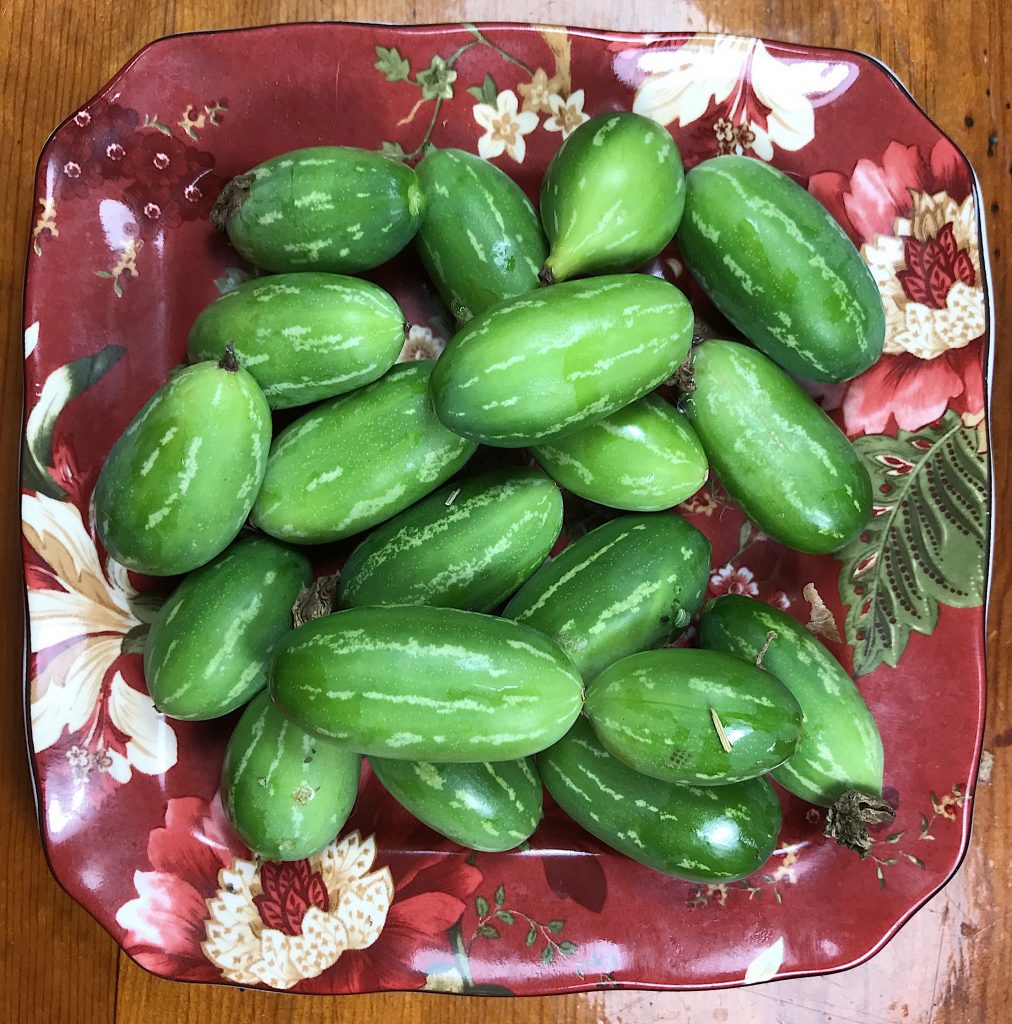
Tindora, or Ivy Gourd, is a hated and appreciated escaped vegetable. Photo by Green Deane
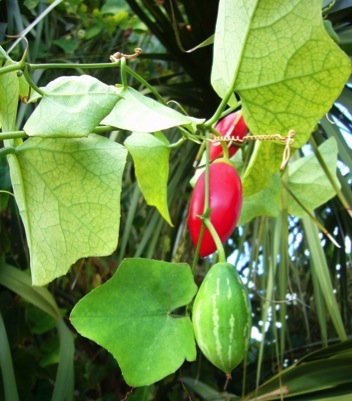
Ivy Gourd fruit ripens to red. Photo by Green Deane
If you have an established Ivy Gourd you know what this entry will be about: They are fruiting now and will do so until cold weather some eight or nine months from now. The Ivy Gourd has a schizophrenic status. It’s an escaped Asian vegetable that grows well locally and is nearly pest free. It seems resistant to most virus and fungus but is attacked about now for three weeks by some lava. I just cut them out and eat the rest. Because the Ivy Gourd is so prolific and resistant it’s popular with home gardeners and permaculturists. On the other side of the issue as it’s not native it is on the radar of the Native Plant Society and the state as an invasive. I personally don’t know how invasive it is because while it’s available but I don’t see it too often in my wanderings. I find it an excellent vegetable, either when green or ripe red. It will probably grow in popularity as more and more people follow permaculture and front yard gardening. To see a video about the Ivy Gourd go here, to read about Ivy Gourd go here.
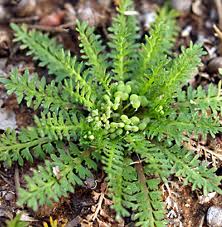
Swinecress is an easy to identify mustard.
Found in abundance this past Sunday in Melbourne was Swinecress. I look for this mustard relative in lawn-like settings usually after the New Year and until warm weather. (This week we will be unseasonally in the 90’s.) There are a couple of notable aspects to Swinecress. One is that its flavor grows in intensity as you eat it. It begins mild and then expands. The other is that once it is seeding it’s nearly impossible to misidentify (and one of the few times the botanical name actually helps us identify the species.) From a flavor point of view it would make a good commercial crop but it’s usually a low grower and relatively small compared to other winter greens. I think it would be a fine plant for the home winter garden. You can read about “naughty” Swinecress here.

Foraging classes are held rain or shine, heat or cold. Photo by Nermina Krenata
The foraging class Saturday, March 28th at Haulover Canal, Merritt Island, has been canceled because the federal area is close because of Covid-19. And no one signed up for the Sunday class at Spruce Creek. I will leave the April schedule as it is for now. I am available for private classes. See my class page.
Saturday, April 4th, Bayshore Live Oak Park, Port Charlotte, FL, 9 a.m. to noon. Meet at the parking lot at the intersection of Bayshore Road and Ganyard Street.
Sunday, April 5th, because of closures int Orange County this has been changed to Colby-Alderman Park in Cassadaga. 9 a.m. to noon, meet near the bathrooms.
For more information about classes go here.
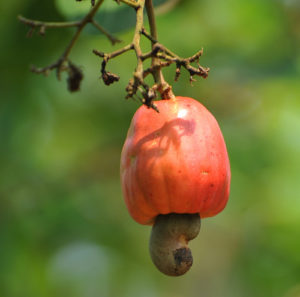
A cashew apple is edible and used to make a drink called Feni.
One of the more strange trees is the cashew. The species is closely related to poison ivy, poison oak, poison sumac, edible sumac, mangos, and pistachios. The cashew itself is an exceptionally toxic tree. The cashew “seed” is actually an enclosed nut inside an enclosed shell. It is surrounded by a toxic sap. The sap is dangerous. The process of making the seed edible is dangerous. While the end product is a tasty nut it is among the least nutritious of tree seeds. Oddly the cashew “apple” is quite edible and before Hurricane Irma we saw them in West Palm Beach. The storm took them out. You can read more about the cashew here.
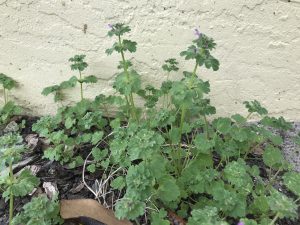
Leggy Henbit closing out our winter season. Photo by Green Deane
I saw some Henbit yesterday though we are approaching April. In northern climates it’s one of the first green plants to pop up after the snow goes (it and chickweed.) Locally Henbit likes the cooler months of the year. It was esteemed by the natives because among all the spring greens it’s not spicy but rather mild if not on the sweet side. Henbit is commonly used in salads but can get lost amid stronger flavors. It’s in the mint family but does not smell or taste minty. It does, however, have a square stem and the blossoms resembles mints. What can be confusing about it is that the leaf shape and stem length is different from young to old leaves. But they all have a scalloped shape. It also has a similar looking, darker relative that is also edible called Dead Nettle. I have a video about it here and an article here.
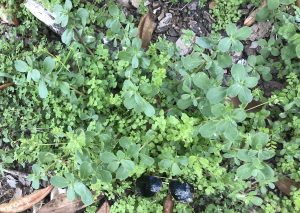
Extra large wild purslane. Photo by Green Deane
The Common Purslane is probably native to India or thereabouts (though that is debatable) and is found nearly around the world. Nearly everywhere it grows all above-ground parts are on the menu except in the United States. Why Purslane is not on main stream grocery store shelves in this country is a mystery. I see it growing everywhere and a lot of it goes home with me for supper or transplanted into the garden. It’s not known for taking up bad chemicals so often all it needs is to be rinsed off. I saw some extremely large pusrlane that dwarfed my sunglasses. As for the commercial varieties of purslane one sees in nurseries and the like they are generally not considered edible. You can see a video here, To read more about Purslane go here.
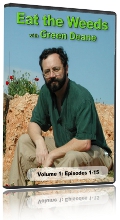
Foraging DVDs
Though your foraging may drop off during Covid-19 travel bans it’s a great time to study wild edibles with my nine DVD set. Each DVDs has 15 videos for 135 in all (that’s $1 a video.) They make a great gift. Order today by the set or individual videos. Some of these videos are of better quality than my free ones on the Internet. They are the same videos but many people like to have their own copy. I burn and compile the sets myself so if you have any issues I handle them personally. There are no middle foragers. I also made more to cope with the quarantines and replace lost class income. To learn more about the DVDs or to order them click here.

Green Deane Forum
Want to identify a plant? Perhaps you’re looking for a foraging reference? You might have a UFO, an Unidentified Flowering Object, you want identified. On the Green Deane Forum we — including Green Deane and others from around the world — chat about foraging all year. And it’s not just about warm-weather plants or just North American flora. Many nations share common weeds so there’s a lot to talk. There’s also more than weeds. The reference section has information for foraging around the world. There are also articles on food preservation, forgotten skills from making bows to fermenting food. Several hard-to-find books are there page for page. Recent posts this week include Spring 2020 Plantings, Light Purple Flowers and Fuzzy Leaves, Red Blossoms Hanging Down, Edible Privacy Fence, Tendrilizing, Calculating COVID-19 Mortality Rate, Nettle Spanakopita, Pawpaws Starting Early? What are those White Blossoms, Brazilian Pepper Revisited, Palmer Amaranth, In The Loop, Tomatoes: A Fruit First, a Vegetable Second, and Butterweed: Annual Warning. You can join the Forum by going to the upper right hand top of this page.
 Donations to upgrade EatTheWeeds.com have gone well. Thank you to all who have contributed to either via the Go Fund Me link, the PayPal donation link or by writing to Green Deane POB 941793 Maitland FL, 32794. There are many needs left such as expanding the foraging teacher page and the page on monotypic edibles. There’s always something and such things get more complex and expensive every year.
Donations to upgrade EatTheWeeds.com have gone well. Thank you to all who have contributed to either via the Go Fund Me link, the PayPal donation link or by writing to Green Deane POB 941793 Maitland FL, 32794. There are many needs left such as expanding the foraging teacher page and the page on monotypic edibles. There’s always something and such things get more complex and expensive every year.
This is weekly newsletter 398, If you want to subscribe to this free newsletter you can find the sign-up form in the menu at the top of the page.
To donate to the Green Deane Newsletter click here.
Below is a Basswood Tree and in suburbia no less. One usually finds them about hammocks and the like. This time of year they are extremely easy to identify. They have a growth attached the fruiting body that resembles a tongue depressor. I have an article on the species here and a video here.
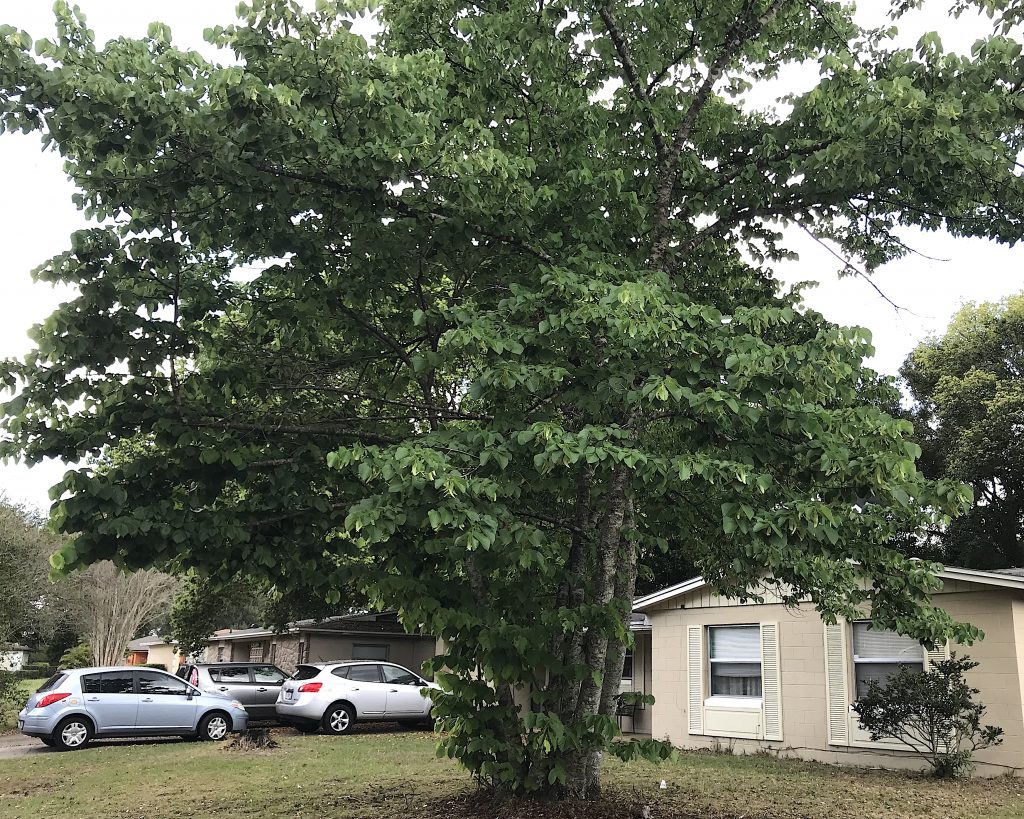
Photo by Green Deane


Hi Dean,
What’s your secret for successfully transplanting purslane. When I try the plants always die.
Thanks!
No secret and easy to do. I pull up some with roots and put it in my yard. I do water it and cover some for a day or two.
Know any reputable place can buy ivy gourd seeds from? Thank you Sharon.
So excited to find your website!
Dear Green, who of us has not been deluded & shocked of merely of hereing of the calamity of coroona ,hence seek to go back to normal ?! I ask you a few lines hoping to contribute as I may according to my age & health. Permit me to submit the followin 4 points scccessively as I suffer somme mobile problems. 1/ Although almost all people have nothing but to discuss the endmic coroa, much has been dealing with things out of contxt & resulted in scaring others. Let ‘s hope the path be corrected by wiser & more experienced encourage by higher authorities such as United Nations.
Dear Green, 2/ Those people who love nature . They have a great rule ;but they are notallowed the space they deserve to say what important o role. Unfortunately, other people think adversely of their role despite the benifit humanity continues to gain from this important section e.g. of foragers, herbalists,ect,ect.
Dear Green, 3/ Health & spesicficly oncologists. I think they are more worth of carryying the burden than other docters by verue of the inhirent language of the science itself which is ready to address the issue of corona. I may give some key words concrned with this literature : e
g. deoxynucleic acid, ribonucleic acid, in ivo, in vitro, mutation, surface area & of course more science is needed specially also from biochemists
Thus, oncologists are expected to have a big say. Not to forget again the relation between ” vius” & ” “crowna” .
Dear Green, 4/. Worldwide section: We should consider this section & rely much if not totally on it because there is no otherwise. Maybe all religions & philosophies agree this the time for supplication
( Minha khulugnakum wa feeha nu’ eedukum wa minha minha nu’eeduku taarutun ukhraa
) Holy Verse.May Almighty God save our world
.